#Princess Feodora of Hohenlohe-Langenburg
Note
might be such a random question but what did you think of the way Victoria brought in Victoria’s half sister in season 3? Did you have any thoughts on that? I thought it was an interesting choice! I wonder if that did happen.
Hi anon! That’s not a stupid question at all! For anyone that doesn’t know, this question is about Queen Victoria’s half sister Princess Feodora of Leiningen and how she made her “glorious” appearance in season 3 of ITV’s Victoria.
I honestly didn’t like her appearance at all. It ruined Victoria and Alberts relationship so much and I was just entirely triggered by her actions. She really was just a mischievous little scheming brat that like completely interrupted the show and like ruined everything for me. I’m pretty sure that this did indeed happened to an extent, but it definitely wasn’t portrayed accurately in the drama.
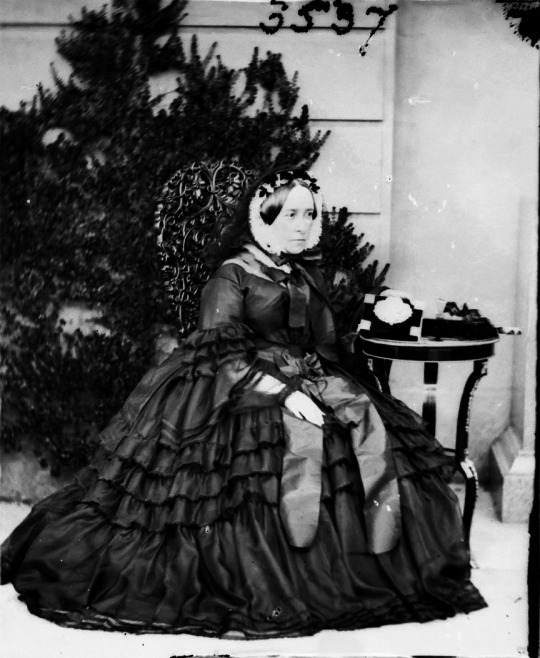
Also Fun Fact! Did you know that Empress Augusta Victoria of Germany (née Princess of Schleswig Holstein) was the Granddaughter of Princess Feodora through her daughter Princess Adelheid of Hohenlohe-Langenburg who was also featured on the show!
Thank you for asking!
#answered ask#Queen Victoria#victoria#period drama#princess Feodora of leiningen#princess adelheid of hohenlohe-langenburg#Empress Augusta Victoria of Germany#Princess Augusta Victoria of Schleswig Holstein#princess feodora
5 notes
·
View notes
Text

Monument to Princess Feodora of Hohenlohe-Langenburg
— by Gustav Amberger
#painting#art#art history#classical art#dark academia#goth#gothic#artist#oil on canvas#oil painting#artblr#art gallery#artists#gothcore#historical painting#historical art#classic academia#gardencore#garden aesthetic#garden#aesthetic
197 notes
·
View notes
Text
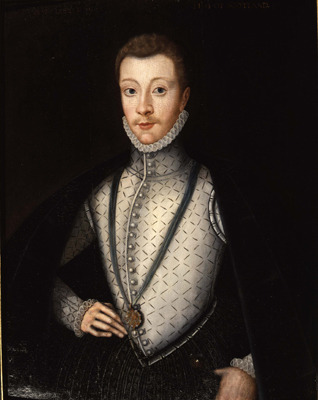
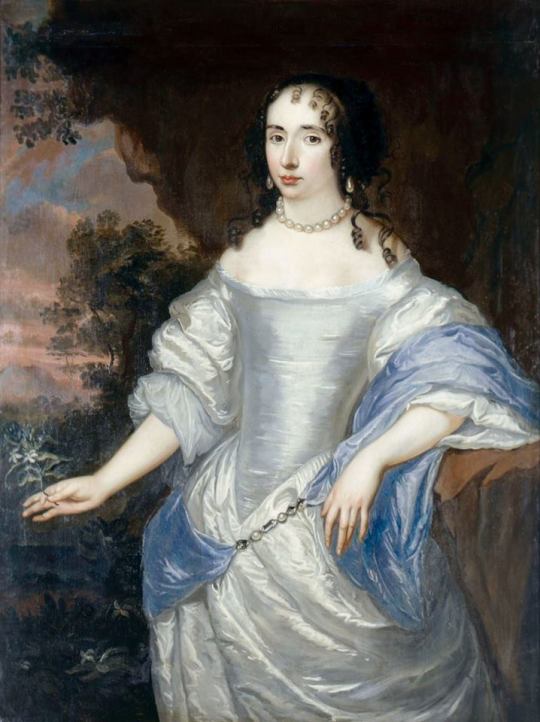
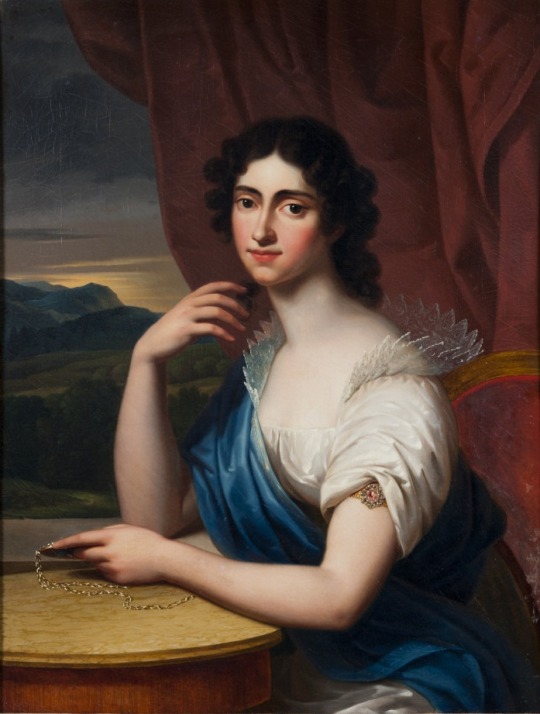
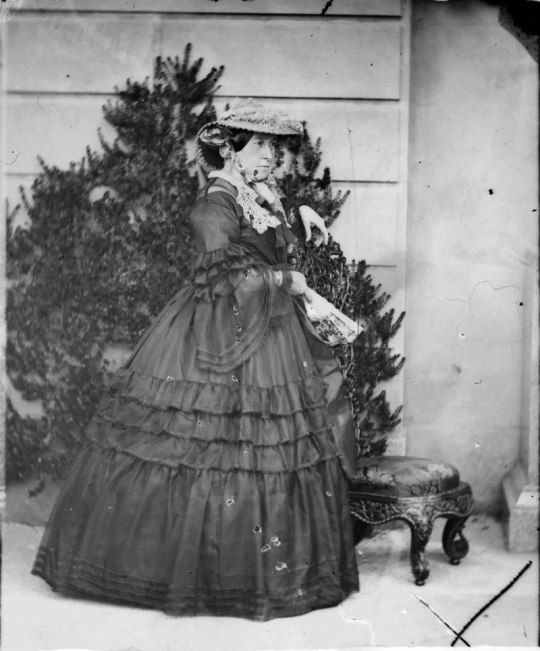

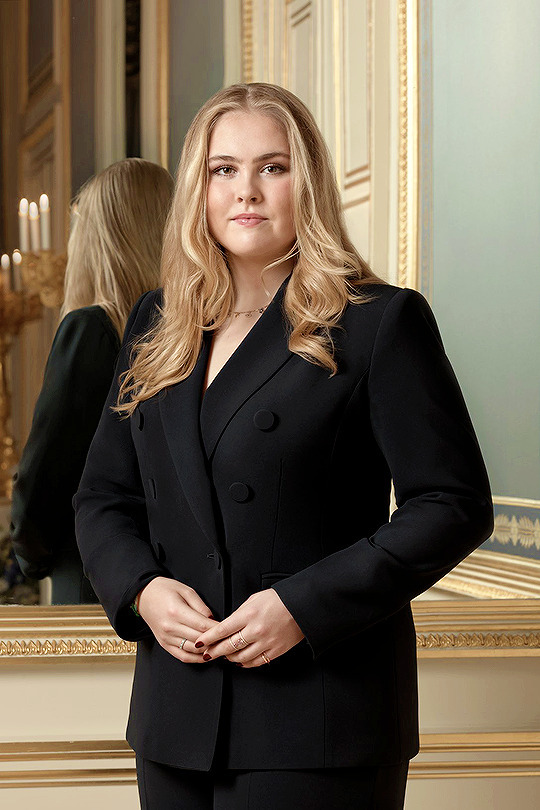
Royal birthdays for today December 7th:
Henry Stuart, King Consort of Scots, 1545
Louise Henriette of Nassau, Electress of Brandenburg, 1627
Maria Christina of Saxony, Princess of Carignano, 1770
Feodora of Leiningen, Princess of Hohenlohe-Langenburg, 1807
Bajrakitiyabha, Princess of Thailand, 1978
Catharina-Amalia, Princess of Orange, 2003
#henry stuart#Louise Henriette of Nassau#Maria Christina of Saxony#Feodora of Leiningen#princess Bajrakitiyabha#princess catharina amalia#royal birthdays#long live the queue
13 notes
·
View notes
Note
I thought Queen Victoria's older half-sister Feodora possibly marrying King George IV was just made-up for the TV show "Victoria" but that's not totally true? Within the episode it's a major source of resentment by Feodora (Kate Fleetwood) towards her family and in particular her little half-sister (Jenna Coleman) which seems like dramatic license, but the actual mini-courtship seems to based on some reality and it went far enough with The Princess Sophia being a promoter of it?
I don’t have much interest in watching the show and can’t speak to it as an adaptation of real-world events, but Victoria made a passing reference to this potential engagement in her 1872 memoir. Reminiscing about visiting George IV in 1826, as a little girl of seven, she remarked that “[t]he King paid great attention to my Sister, and some people fancied he might marry her”. Personally, I doubt whether George IV would have really been interested in marrying again (given the utter disaster of his first marriage), much less to a 19-year-old some 45 years his junior, especially when he was in pretty poor health, in the last years of his life, and already had a long-term mistress. (Nor did George IV need to guarantee the succession, given that he had a ready heir presumptive in his brother William, as well as four nieces and nephews by 1826, Victoria included.)
Nevertheless, the mere threat of Feodora marrying someone rich and powerful, even if not the King, seems to have motivated the Duchess of Kent and Sir John Conroy to wed Feodora to someone distant and powerless. Indeed, Conroy bluntly reminded the Duchess that “[i]t is necessary for your and the Pss. Victoria’s interest that it [i.e Feodora’s marriage] should take place”, because “the interest you ought to have over [Victoria] will be endangered if she sees an older sister not so alive to it as she should be” (adding ominously that “once your authority is lost over the Princess V. you will never regain it”). The solution, for the Duchess and Conroy, was Prince Ernest of Hohenlohe-Langenburg, ruler of a tiny German toy kingdom with very little money (certainly by princely standards).
22 notes
·
View notes
Text

Title: Princess Feodora of Hohenlohe-Langenburg
Artist: Franz Xaver Winterhalter
Date: 1855
Style: Neo-Rococo
Genre: Portrait
26 notes
·
View notes
Photo


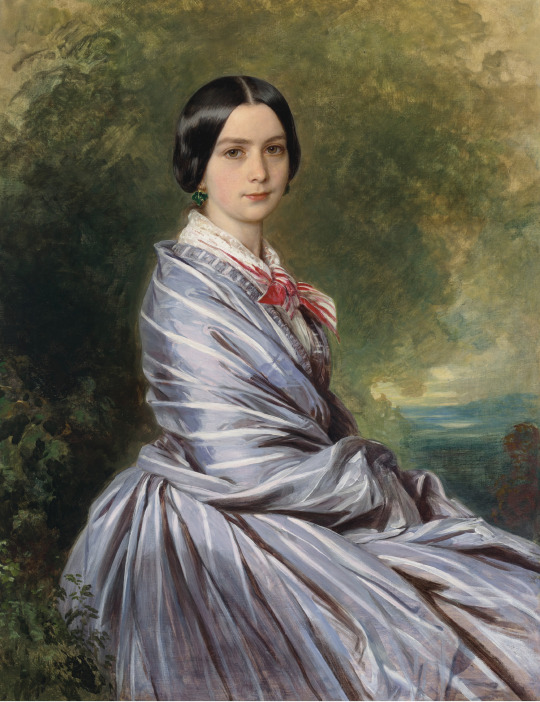


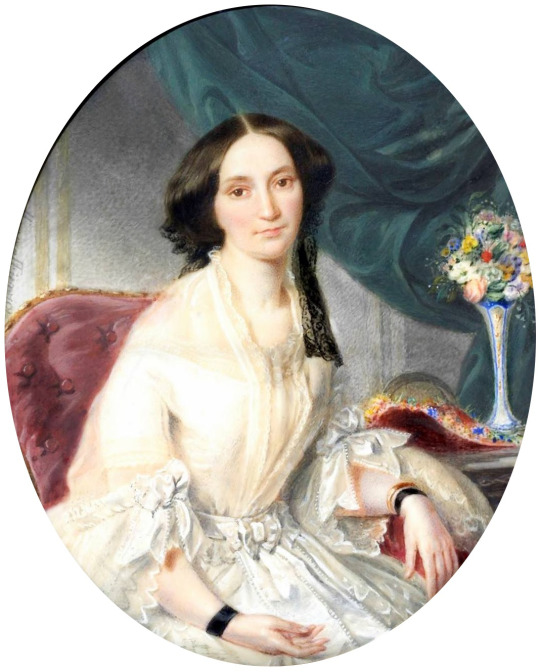




1840s fashion:
Top row left: 1840-1848 Maria Mathilda Moll, née Sterkey, by Olof Södermark (auctioned by Stockholms Auktionsverk). From auktionsverket.com-auction-fine-arts-2012-12-04-2338-olof-sodermark-romersk-flicka-vid-balustrad- 1641X2161 @72 6.7Mp.
Top row right: 1846 Noble Lady by Ferdinand Georg Waldmüller (auctioned by Christie's). From mutualart.com/Artwork/Portrait-of-a-Lady/8A0F49E7DBD87528# 1910X2388 @144 4.1Mp.
Second row left: 1848 Augusta Wichrow by Franz Xaver Winterhalter (Christie's - 13Oct21 auction Lot 11) 3131X4073 @150 4.9Mj.
Second row right: 1840 Elena Pavlovna by Vladimir Hau (location ?). posted to the Alexander Palace Time Machine Discussion Forum by Lisa on 14 February 2006 1106X1276 @72 414kj.
Third row left: 1840 Feodora, Princess of Hohenlohe-Langenburg with her daughter Princess Adelaide by Sir George Hayter (Royal Collection). From Wikimeia; removed spots with Photoshop 1616X1969 @300 630kj.
Third rów right: 1840 Katarzyna Potocka z Branickich by Stanisław Marszałkiewicz (location ?). From Wikimedia; removed spots with Photoshop 1068X1329 @96 386kj.
Fourth row left: 1840 Königin Therese von Bayern by Franz Xaver Nachtmann (location ?). From Wikimedia 1217X1500 @72 470kj. There are too many spots to fix.
Fourth row right: 1840 Louise Marie Therese Charlotte Isabelle of France (1812-1850), daughter of Louis Philippe I of France and Maria Amalia of Naples and Sicily by Magdalena Dalton (Royal Collection) From pinterest.com/AlexyMet/ritratti-aristocratici-eleganti/.
Fifth row left: 1840 La comtesse de Ségur by ? (Château de Versailles - Versailles, Île-de-France, France). From france-pittoresque.com/spip; enlarged by half.php?article13161; removed more obvious spots w Pshop 752X932 @96 124k.
Fifth row right: 1840 Maria Anna von Savoyen by Johann Stadler (Albertina - Wien, Austria). From Wikimedia 1824X2741 @200 1.2Mj.
#1840s fashion#Romantic era fashion#early Victorian fashion#straight hair#wrap#off shoulder V neckline#high V neckline#fan-front bodice#lace collar#bonnet
10 notes
·
View notes
Text
who: mecklenburgish line of succession
The line was succession to the Mecklenburgish throne was changed from agnatic primogeniture to male preference primogeniture on 1 January 1930 upon the descendants of Heinrich Ludwig I.
The line of succession was changed from male preference primogeniture to absolute primogeniture for the descendants of Wilhelm Franz I on 1 January 1990, male preference primogeniture continues for the rest of Heinrich Ludwig I’s descendants.
Conditions of eligibility until 2006
Legitimate descendant of Heinrich Ludwig I (legitimised children are not applicable)
Raised protestant
Marries with the consent of the Monarch
Conditions of eligibility from 2006
Legitimate descendant of Heinrich Ludwig I (legitimised children are not applicable)
Consent to marry is required for the first seven in line to remain eligible
Prior to 1982, all people in the line of succession had to make marriages to members of ruling royal houses, former ruling royal houses or noble families to remain in the line of succession.
LINE OF SUCCESSION ON 1 DECEMBER 2014
HM Heinrich Ludwig I (b. 1890 d. 1954)
…..HM Paul Friedrich II (b. 1919 d. 1982)
……….HM King Wilhelm Franz I (b. 1949 d. 1992)
……………HM Queen Karolina Augusta I (b. 1988)
……………(1) HRH Prince Klaus Wilhelm, Duke of Havel and Mecklenburg-Schwerin (b. 1992)
……….(2) HRH Prince Albrecht Gustav, Duke of Bad Doberan (9. 1953)
……………(3) HRH Prince Paul Ludwig of Mecklenburg (b. 1983)
……………(4) HRH Prince Christian Franz of Mecklenburg (b. 1987)
……………(5) HRH Princess Marie Leopoldine of Mecklenburg (b. 1985)
……………(6) HRH Princess Marie Josefine of Mecklenburg (b. 1989)
……….(7) HRH Princess Heinrike Franziska, Duchess of Ratzeburg (b. 1940)
……….(8) HRH Princess Elisabeth Mathilde, Duchess of Güstrow (b. 1942)
……………(9) HSH Prince Ludwig of Hohenlohe-Langenburg (b. 1973)
………………..(10) HSH Princess Juliana of Hohenlohe-Langenburg (b. 2005)
………………..(11) HSH Princess Lucinda of Hohenlohe-Langenburg (b. 2006)
……………(12) HSH Prince Konstantin of Hohenlohe-Langenburg (b. 1976)
………………..(13) HSH Prince Rupprecht of Hohenlohe-Langenburg (b. 2012)
………………..(14) HSH Prince Samuel of Hohenlohe-Langenburg (b. 2014)
……….(15) HRH Princess Marie Anastasia, Duchess of Grevesmühlen (b. 1944)
……………(16) HH Prince Karl Viktor of Hesse-Kassel (b. 1973)
………………..(17) HH Prince Otto of Hesse-Kassel (b. 2005)
………………..(18) HH Princess Mafalda of Hesse-Kassel (b. 2008)
………………..(19) HH Princess Pauline of Hesse-Kassel (b. 2010)
……………(20) HH Prince Ernst Albert of Hesse-Kassel (b. 1974)
……………(21) HH Prince Nikolaus Emmanuel of Hesse-Kassel (b. 1975)
………………..(22) HH Prince Daniel of Hesse-Kassel (b. 2008)
………………..(23) HH Prince Peter of Hesse-Kassel (b. 2010)
………………..(24) HH Princess Milena of Hesse-Kassel (.b 2013)
……….(25) HRH Princess Cecilie Auguste, Duchess of Ludwigslust (b. 1947)
……………(26) HSH Prince Friedrich Magnus of Schwarzburg (b. 1977)
………………..(27) HSH Prince Bernhard of Schwarzburg (b. 2009)
………………..(28) HSH Prince Joachim of Schwarzburg (b. 2011)
………………..(29) HSH Princess Theresia of Schwarzburg (b. 2007)
………………..(30) HSH Princess Antoinette of Schwarzburg (b. 2013)
……………(31) HSH Princess Anne Therese of Schwarzburg (b. 1980)
……….(32) HRH Princess Alexandrine Luise, Duchess of Waren (b. 1951)
……………(33) HH Princess Ingeborg, Marchioness of Bowmont and Cessford (b. 1982)
……………(34) HH Princess Sigrid of Schleswig-Holstein-Sonderburg-Glücksburg (b. 1983)
……….HRH Princess Ingrid Sophie, Duchess of Teterow (b. 1955 d. 2012)
…..(35) HRH Princess Marie Elisabeth, Duchess of Parchim (b. 1921)
……….(36) HH Prince Harald of Denmark (b. 1953)
……………(37) HH Prince Oskar of Denmark (b. 1983)
……………(38) HH Prince Axel of Denmark (b. 1985)
……………(39) HH Princess Louisa of Denmark (b. 1982)
……….(40) HH Princess Feodora of Liechtenstein (b. 1955)
……………(41) HSH Prince Adam Karl of Liechtenstein (b. 1986)
……………(42) HSH Prince Peter Gregor of Liechtenstein (b. 1991)
……………(43) HSH Princess Bernadette Sophia of Liechtenstein (b. 1984)
……………(44) HSH Princess Johanna Eleonore of Liechtenstein (b. 1988)
0 notes
Text

Princess Feodora of Hohenlohe-Langenburg and her fiancé Emich, 5th Prince of Leiningen in 1894.
Both were related to Queen Victoria, Feodora being the granddaughter of Victoria's beloved half-sister Princess Feodora of Leiningen and Emich was the grandson of Victoria's half-brother Carl, 3rd Prince of Leiningen.
They were married on 12 July 1894 in Langenburg.
The couple had five children, one girl and four boys. The eldest son died during World War I.
Feodora's only brother was married to Princess Alexandra of Saxe-Coburg and Gotha who was Queen Victoria's granddaughter.
Their second son, Prince Karl of Leiningen married Grand Duchess Maria Kirillovna, Queen Victoria's great-granddaughter.
Photo: Royal Collection Trust / © Her Majesty Queen Elizabeth II 2022.
#princess feodora of hohenlohe-langenburg#emich 5th prince of leiningen#royal engagement#1894#1890s#leiningen#german royal#german royalty
13 notes
·
View notes
Photo



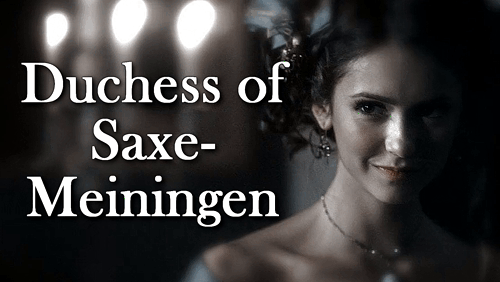


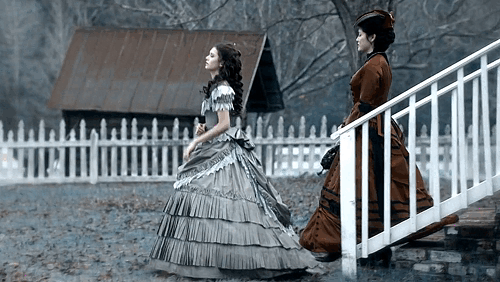



House of Hohenlohe-Langenburg & of Wettin: Princess Feodora of Hohenlohe-Langenburg, The Duchess of Saxe-Meiningen
Feodora was born as the youngest of six children to Ernst I., The Prince of Hohenlohe-Langenburg, and his wife Princess Feodora of Leiningen, the half-sister of Queen Victoria. Feodora’s older sister is Princess Adelheid of Hohenlohe-Langenburg, The Duchess of Schleswig-Holstein, who was the mother of the German Empress Augusta Victoria, who then again married the oldest son of Feodora’s and Adelheid’s cousin German Empress Victoria, Princess Royal.
Feodora was to married George II, The Duke of Saxe-Meiningen on October 23rd, 1858 at the age of only 17. She was completely unprepared for the role of a duchess and was also in constant competition with the deceased first wife of the duke, Princess Charlotte of Prussia, who by the way had also been a daughter of Feodora’s cousin Victoria, Princess Royal. Unlike Charlotte, Feodora was described as a spoiled girl that showed no interest at all in art or any other form of education. Her husband tried to educate her what was encouraged by Feodora’s mother as well but the duke soon realised that Feodora would never be as clever or witty as his first wife had been.
The Duke mainly married Feodora to provide his already existing children with a mother but the couple themselves would have three sons of their own. But after Prince Viktor’s, the youngest, death shortly after birth, Feodora preferred to stay away from Meiningen as much as possible.
Feodora died on February 10th, 1872, at the age of only 32. She had contracted scarlet fever in January the same year. Although she and her husband never had led a marriage of love, he was geniunely distraught when she got sick and sent telegrams to her family, often twice per day.
It can be theorized that Feodora’s sister Adelheid named her youngest daughter Princess Feodora of Schleswig-Holstein, who was born in 1874, after her. Two of her other nieces were called Feodora/e as well but as they were born years before her death it is more likely that they were named after their grandmother Princess Feodora of Leiningen .
// Nina Dobrev in The Vampire Diaries
#historic women#women in history#Victorian Era#historyedit#German history#European history#1800s#19th century#House of Hohenlohe-Langenburg#House of Wettin#House of Saxe-Meiningen#Princess Feodora of Hohenlohe-Langenburg#Duchess Feodora of Saxe-Meiningen#Nieces of Queen Victoria
134 notes
·
View notes
Text
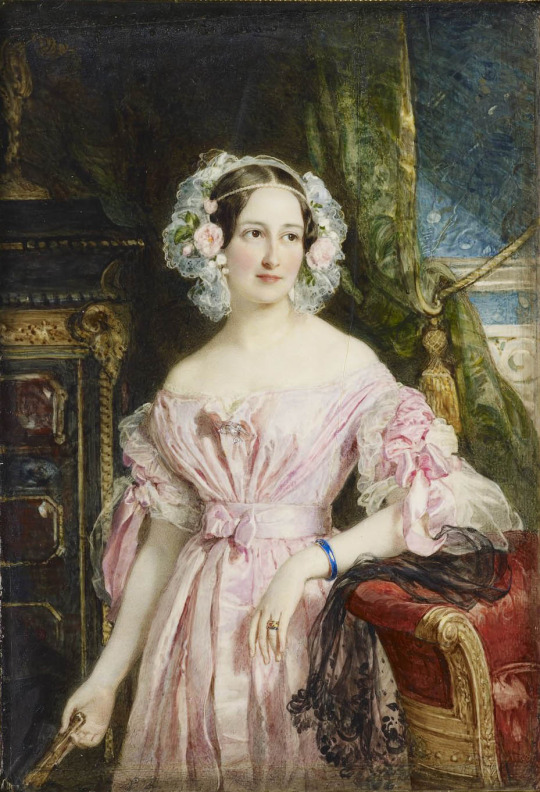
Portrait of Princess Feodora of Leiningen, Princess of Hohenlohe-Langenburg, 1838, by William Ross (1794-1860)
#art#portrait#princess feodora#princess feodora of leiningen#germany#british art#19th century#1830s#william ross
71 notes
·
View notes
Photo
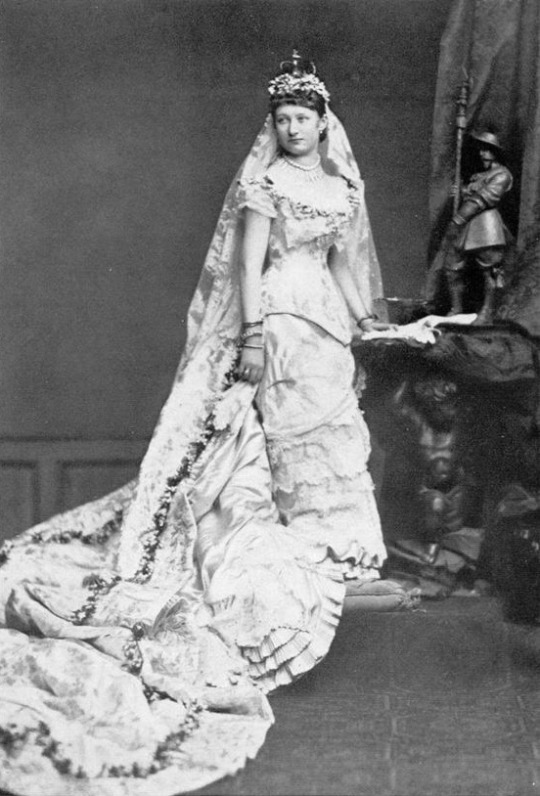
The prescriptive Empress of Germany, Princess Augusta Victoria Amelia Louisa Marie Constance, is the eldest of five children of the late Grand Duke and the Grand Duchess of Schleswig-Holstein-Sonderburg-Augustenburg. She was born in the little parish of Dantzig, near Frankfort on the Oder, on the 22nd October 1858. Her mother, daughter of Ernest, Prince of Hohenlohe-Langenburg, is sister of Count Gleichen, who married Queen Victoria's half-sister Feodora, niece of the Prince Christian of Schleswig-Holstein. Related to the royal House of Denmark, the Princess counts other honourable, if humbler, connections, her aunt, the Princess Henriette, having married the celebrated Dr. Esmarck, professor of surgery at Kiel. The fallen fortunes of her father, the Grand Duke compelled him to live in strict retirement and to order his household with an austere simplicity. In the adversity that had befallen him, the ruined prince found a solace and an interest in devoting himself to the education of his children. The high mental training they received is principally due to the direction he gave to their studies. An accomplished English lady resided for years with the princesses, and helped in the task of their education. The Princess Augusta-Victoria passed a studious youth in the castle overlooking the quiet village. Doubtless the frugal surroundings of her childhood and girlhood, the sense of her illustrious birth and connections, helped form her character, and to give to it seriousness and dignity. When in later years, she left that retired home to appear before the German nation as the bride of the grandson of the Emperor, the reputation of her solid attainments and womanly accomplishments had preceded her, and the people proudly said of her that she was “a real German princess.” It must have appeared an instance of poetic justice to the Grand Duke when the Kaiser's brilliant and beloved grandson, whose hardy spirit and heroic carriage made him bear so strong a likeness to that sovereign who had despoiled him of his dominions, in pursuance of the ideal he had set to himself of reigning over a united Germany, came over and over again to the simple home at Dantzig. There was no mistaking the devotion of the gallant young prince to the fair and tall princess, the eldest of the family group there. At a hunting party given in the late autumn of 1879 at Castle Prinkinan, the seat of the Augustenberg family in Silesia, it is believed that the Grand Duke was left in no further doubt as to the likelihood of his his being ranked in the years to come as one of the ancestors of future German emperors. He did not live, however, to see the consummation of the union that would have gone far to copensate him for the shadows that had gathered about his lot. He died in January 1880. In the following June the Princess Augusta-Victoria was formally betrothed to Prince Wilhelm in the presence of the royal family of Prussia at the castle of Babelsburg, the Emperor's beautiful country seat set at the wooded heights dominating Potsdam. The greater part of the time between her betrothal and marriage the Princess spent in England at Cumberland Lodge. Many may remember the blonde-haired blue-eyed lady, of tall and elegant stature, whose natural stateliness of bearing was softened by a kind and courteous address. In person she appeared to be the type of what the folk of the Fatherland called her, “a real German princess.” On the 21st of February 1881, the marriage of Prince Wilhelm of Prussia and Princess Augusta-Victoria was celebrated in the chapel of the Imperial Palace at Berlin, in the presence of a notable gathering of potentates, princes, and of the wisest and bravest men in the empire. Among those present none, it was said, rejoiced more at the marriage than did the aged Emperor, or gave a heartier welcome to the dowerless bride of Prince Wilhelm. M. de Vassili gives, in the Revue Nouvelle, a portrait sketch of this prince, who seems to possess an irrestitable power of attraction over all who approach him. The description is sullied with some pages Mme. Adam would have done well not to publish, yet even the French count is forced to pay a reluctant homage to the brilliant wit, the high spirit, the genial sympathetic nature, the indomitable courage, enterprise, and ambition the young prince has given proof of. Idolised by his grandfather, for whom he nourishes a sort of hero-worship, Prince Wilhelm is adored by the army, and to the welfare of that army he is devoted.
On the 6th of May, 1882, the eldest son of Prince Wilhelm and Princess Augusta-Victoria, Prince Frederick William, was born at Potsdam.
#Empress Augusta Victoria#Hohenzollern#Schleswig-Holstein#Kaiser Wilhelm II#magazine article#1880s#prussian royal family
29 notes
·
View notes
Photo

Princess Feodora of Hohenlohe-Langenburg (7 July 1839 – 10 February 1872) was a daughter of Ernst I, Prince of Hohenlohe-Langenburg and Princess Feodora of Leiningen. By her marriage to Georg of Saxe-Meiningen, she would become Duchess of Saxe-Meiningen upon his accession to the ducal throne in 1866.
#Feodora of Hohenlohe-Langenburg#House Hohenlohe-Langenburg#XIX century#people#portrait#paintings#art#arte
10 notes
·
View notes
Photo
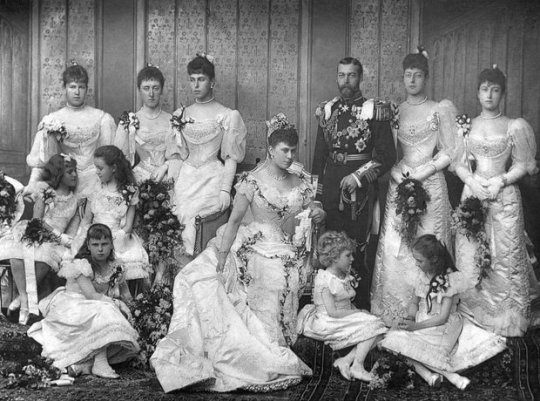
𝒲𝑒𝒹𝒹𝒾𝓃𝑔 𝒲𝑒𝒹𝓃𝑒𝓈𝒹𝒶𝓎
~~~~~~~~~~~~~~~~~~~~~~~~~~~~~~~~~~~~~~~~~~~~~~~~~~~~~~~~~~~
𝒯𝒽𝑒 𝒞𝑜𝓊𝓅𝓁𝑒
His Majesty George V The King & Her Majesty Queen Mary
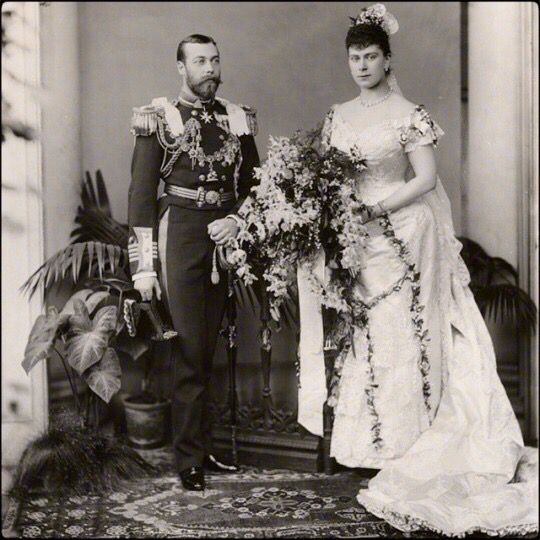
~~~~~~~~~~~~~~~~~~~~~~~~~~~~~~~~~~~~~~~~~~~~~~~~~~~~~~~~~~~
𝒲𝑒𝒹𝒹𝒾𝓃𝑔 𝒟𝒶𝓉𝑒 & 𝐿𝑜𝒸𝒶𝓉𝒾𝑜𝓃
The Royal Wedding took place at 12:30PM on Thursday, July 6th, 1893 in The Chapel Royal (Left Picture) at St. James Palace (Right Picture) in London, England

~~~~~~~~~~~~~~~~~~~~~~~~~~~~~~~~~~~~~~~~~~~~~~~~~~~~~~~~~~~
𝐸𝓃𝑔𝒶𝑔𝑒𝓂𝑒𝓃𝓉 𝒮𝓉𝑜𝓇𝓎
♕ Previous Engagement: Her Majesty Queen Mary (Top Picture) was engaged before meeting His Majesty George V. Mary had become engaged to His Royal Highness Prince Albert The Duke of Clarence and Avondale (Bottom Picture), the older brother of George. Sadly the wedding never happened, as The Duke had fell ill with the Flu which then took a bad turn, turning the flu into Pneumonia. The Duke passed away on Friday, January 8th, 1892 at The Sandringham House in Norfolk, England.

♕ Staying In The Family - Part 1: Her Majesty Queen Victoria (George’s Grandmother: Left Picture) wanted the then His Royal Highness Prince George of Wales, to marry either Her Majesty Queen Marie of Romania (His Cousin: Middle Picture) or Grand Duchess Victoria Feodorovna (His Cousin: Right Picture). George sadly was not fond of either of the two women & Her Majesty Queen Marie of Romania (Middle Picture) did react to George’s proposal to her by rejecting him.

♕ “I’m Too Young”: Even after his grandmother tried to wed George & his two cousins, the young prince refused to be married. “I still think marrying too young is a bad thing. The one thing I never could do is to marry a person that didn’t care for me. I should be miserable for the rest of my life.” George wrote this to his grandmother stating that he was too young to be married & even if he did marry young, he would marry someone he loved.
♕ Staying In The Family - Part 2: George’s grandmother & Mary had met during her engagement to the now parted Duke, & Queen Victoria was fond of Mary. She had spoken to Mary to see what she would think about marrying her fiancé’s brother. This was very embarrassing for both George & Mary, as Mary’s fiancé's & George’s brother, had only been dead for 1 year & the two were still in mourning. The couple began to feel the pressures of the royal life. Mary began to feel pressure from not only her family but George’s family to be a married woman. George felt the pressure of his new position as second-in-line to the throne, he was still recovering from the proposal rejection of his cousin Her Majesty Queen Marie of Romania, & he also had no idea if Mary even had romantic feelings towards him.
♕ The Proposal: After a long conversation with George’s favorite aunt Olga Constantinovna of Russia (Also known as Queen Olga of Greece: Left Picture), the young duke was urged to propose to his brother’s fiancé Mary. George had help with his proposal from his sister Her Royal Highness Louise The Princess Royal (Middle Picture) & his brother-in-law Alexander Duff 1st Duke of Fife (Louise’s husband: Right Picture). On Wednesday, May 3rd, 1893, Louise had “arranged” to have tea with Mary. When Mary arrived to have tea with Louise, she had found George & Louise waiting for her instead of just Louise. The Princess Royal had suggested that the couple go to the garden to go watch the frogs that lived in the garden pond. The duke then proposed to Mary by the pond & she happily accepted George’s proposal. The couple came to learn how to love & care for each other deeply, despite the stress & heartbreak of the last year.

~~~~~~~~~~~~~~~~~~~~~~~~~~~~~~~~~~~~~~~~~~~~~~~~~~~~~~~~~~~
𝒯𝒽𝑒 𝒲𝑒𝒹𝒹𝒾𝓃𝑔
♕ Morning: That Thursday morning, when George was walking the corridors of Buckingham Palace, he accidentally spotted his bride. As tradition, Bride & Groom are never supposed to see each other (unless a private moment is planned by the couple to meet with each other before the wedding) because it is bad luck. As George spotted Mary, he proceeded to make a low & courtly bow towards the princess, a sweet moment many say that Mary never forgot.
♕ Wedding Party: The Royal Wedding was attended by 5 Bridesmaids, 5 Junior Bridesmaids, & 2 Supporters of The Groom.
♕ Wedding Officiant: The Archbishop of Canterbury Edward White Benson (Left Picture) performed the ceremony. He was assisted by The Bishop of London Frederick Temple (Middle Picture), The Bishop of Rochester Randall Thomas Davidson 1st Baron Davidson of Lambeth (Right Picture), & 5 other priests.
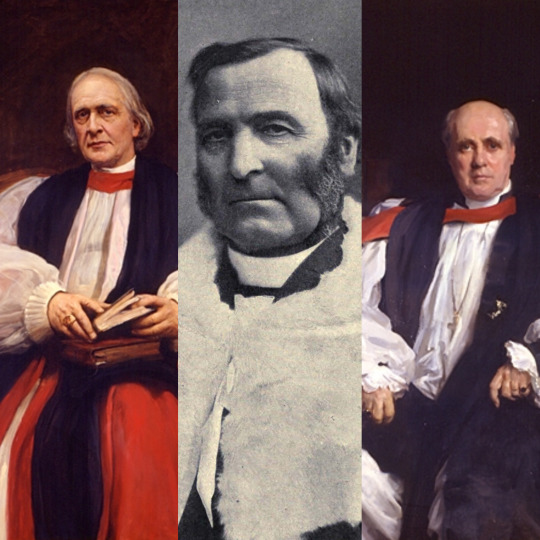
♕ Register Signing Tradition: As Tradition during all Royal Weddings, the Register must be signed. The Register of the Wedding of His Majesty George V The King & Her Majesty Queen Mary was signed by Her Majesty Queen Victoria, The Prime Minster William Ewart Gladstone (Pictured Below), & all other royal personages that were present at the wedding.
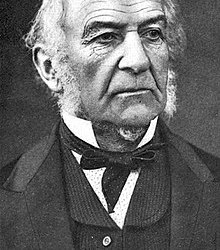
♕ Balcony Tradition: As Tradition of all Royal Weddings, the Bride & Groom along with family, made an appearance on the Buckingham Palace balcony. Even Queen Victoria made a rare public appearance when she joined the couple on the Balcony.
♕ Official Portraits (Photo is in Order): The Official Painters of the Royal Wedding were Heinrich Anton von Angeli, Laurits Tuxen, & Sir Samuel Luke Fildes

♕ Title Change: As Royal Tradition, the Groom (Sometimes) & Bride’s (Always) Title will change. Mary’s Title changed from Her Serene Highness Princess Victoria Mary of Teck to Her Royal Highness The Duchess of York. George’s Title changed from His Royal Highness Prince George of Wales to His Royal Highness The Duke of York.
~~~~~~~~~~~~~~~~~~~~~~~~~~~~~~~~~~~~~~~~~~~~~~~~~~~~~~~~~~~
𝒢𝓊𝑒𝓈𝓉 𝐿𝒾𝓈𝓉
The royal parties traveled from Buckingham Palace to St. James Chapel in 4 large carriages.
♕ First Carriage: Members of the Household.
♕ Second Carriage: The Groom & His Supporters (Mentioned Below in The Guest List)
♕ Third Carriage: The Bride, His Highness Francis The Duke of Teck (The Bride’s Father: The Left Picture), & His Serene Highness Prince Adolphus of Teck (The Bride’s Brother: The Right Picture)

♕ Fourth Carriage: Her Majesty Queen Victoria (The Groom’s Grandmother), Her Royal Highness The Duchess of Teck (The Bride's Mother: Left Picture), Prince Francis of Teck (The Bride’s Brother: Middle Picture), & Alexander Cambridge 1st Earl of Athlone (The Bride’s Brother: Right Picture)
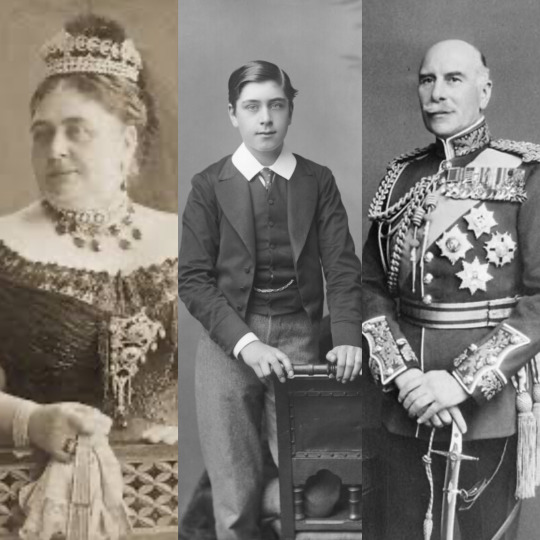
♕ Wedding Party:
The 5 Bridesmaids: Her Royal Highness The Princess Victoria (The Groom’s Sister), Her Majesty Maud The Queen of Norway (The Groom’s Sister), Grand Duchess Victoria Feodorovna of Russia (The Groom’s First Cousin: Mention Above In Staying In The Family - Part 1), Her Royal Highness Alexandra The Princess of Hohenlohe-Langenburg (The Grooms First Cousin), & Princess Beatrice of Saxe-Coburg and Gotha (The Groom’s First Cousin)
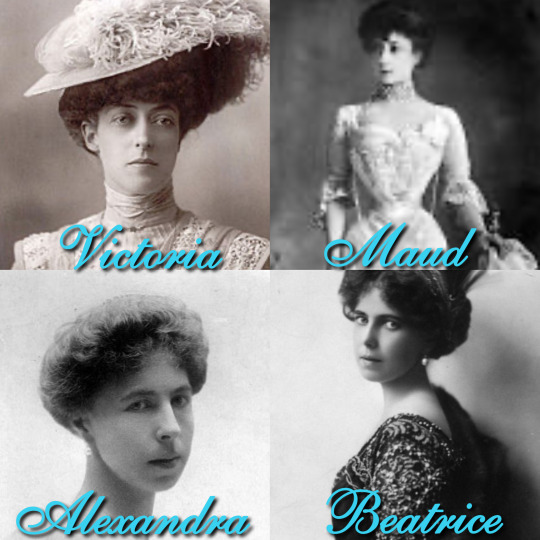
The 5 Junior Bridesmaids: 1. Her Royal Highness Margaret The Crown Princess of Sweden Duchess of Scania (The Groom’s First Cousin). 2. Lady Patricia Ramsay (The Groom’s First Cousin), 3. Her Royal Highness Alice Princess Andrew of Greece and Denmark (also known as Mother Superior Alice-Elizabeth & Great-Grandaughter of Queen Victoria), 4. Queen Victoria of Spain (The Groom’s Cousin), & 5. Her Highness Princess Helena Victoria (The Groom’s Cousin)
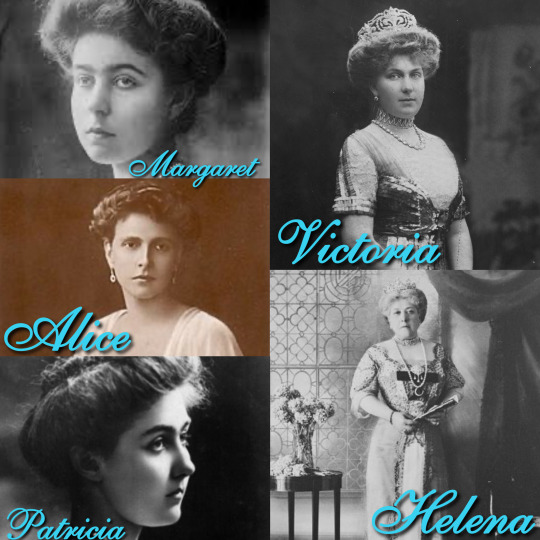
The Grooms Supporters: His Majesty Edward VII The King (The Groom’s Father: Left Picture) & His Royal Highness Alfred The Duke of Saxe-Coburg and Gotha (The Groom’s Uncle: Right Picture)

𝒢𝓊𝑒𝓈𝓉𝓈
𝒯𝒽𝑒 𝒢𝓇𝑜𝑜𝓂'𝓈 𝐹𝒶𝓂𝒾𝓁𝓎 (Not Mentioned In The Wedding Party)
Her Majesty Queen Alexandra (Mother)
Her Royal Highness The Princess Royal (Sister & Brother In Law: Mentioned Above in The Proposal)
Her Royal Highness Princess Arthur of Connaught, Duchess of Fife (Niece)
Her Imperial and Royal Highness Maria The Dowager Duchess of Saxe-Coburg and Gotha, Duchess of Edinburgh (Paternal Aunt)
His Royal Highness Arthur Duke of Connaught and Strathearn & Her Royal Highness Louise The Duchess of Connaught and Strathearn (Paternal Uncle & Aunt)
Prince Arthur of Connaught (First Cousin)
Her Imperial Majesty Victoria The Empress Frederick
His Royal Highness Prince Henry of Prussia and Princess (Princess Irene) Henry of Prussia (First Cousins)
Her Royal Highness The Grand Duchess of Hesse and by Rhine
The Most Honorable Victoria The Dowager Marchioness of Milford Haven & The Most Honorable Louis The Marquess of Milford Haven (First Cousin & Her Husband)
His Highness Albert The Duke of Schleswig-Holstein (First Cousin)
Her Royal Highness The Princess Louise Duchess of Argyll & John Campbell 9th Duke of Argyll Marquess (Marquis) of Lorne (Paternal Aunt & Uncle)
Her Royal Highness The Princess Beatrice & His Royal Highness Prince Henry of Battenberg (Paternal Aunt & Uncle)
The Most Honorable Alexander The Marquess of Carisbrooke (First Cousin)
His Majesty Christian IX of Denmark and Queen Louise of Denmark (Maternal Grandparents)
His Royal Highness Prince Valdemar of Denmark (Maternal Uncle)
Her Imperial Majesty Maria Empress of All the Russias
His Imperial Majesty Nicholas II Emperor and Autocrat of All the Russias (First Cousin)
Ernest II The 7th Prince of Hohenlohe-Langenburg (Half-Second Cousin)
His Majesty Albert I The King of the Belgians (Paternal Second Cousin - Once Removed)
Prince Philipp of Saxe-Coburg and Gotha (Paternal Second Cousin - Once Removed)
Lady Feodora Gleichen (Second Cousin)
Lady Helena Gleichen (Second Cousin)
Countess Victoria Gleichen (Second Cousin)
𝒯𝒽𝑒 𝐵𝓇𝒾𝒹𝑒'𝓈 𝐹𝒶𝓂𝒾𝓁𝓎
His Royal Highness George The Duke of Cambridge (Maternal Uncle)
Her Royal Highness Augusta The Dowager Grand Duchess of Mecklenburg-Strelitz & His Royal Highness Frederick The Grand Duke of Mecklenburg-Strelitz (Maternal Aunt & Uncle)
Colonel Augustus FitzGeorge (First Cousin)
𝒪𝓉𝒽𝑒𝓇 𝐹𝑜𝓇𝑒𝒾𝑔𝓃 𝑅𝑜𝓎𝒶𝓁𝓉𝓎
Prince William “Edward” of Saxe-Weimar & Her Serene Highness Augusta Princess William “Edward” of Saxe-Weimar
The Maharaja of Bhavnagar
Jagatjit Singh, The Raja of Kapurthala
The Thakur Sahib of Morbi
Bhagvat Singh, The Thakur Sahib of Gondal
𝒜𝓂𝒷𝒶𝓈𝓈𝒶𝒹𝑜𝓇𝓈 & 𝐸𝓃𝓋𝑜𝓎𝓈
Count Ferdinand von Zeppelin
Russian Ambassador Baron Egor Egorovich Staal Madam de Staal
German Ambassador Paul von Hatzfeldt
The Turkish Ambassador
Austro-Hungarian Ambassador Count Franz Deym & Countess Deym
The Italian Ambassador & Countess Tornielli
The Spanish Ambassador
The United States of America Ambassador Thomas Bayard and Mrs. Mary (Clyme) Bayard
The Belgian Minister & Madam Solvyns
The Danish Minister & Madam de Bille
Portuguese Minister Luís Pinto de Soveral 1st Marquis of Soveral
Romanian Minister Alexandru Plagino
The Greek Chargé d'Affaires & Madam Romanos
𝒫𝑜𝓁𝒾𝓉𝒾𝒸𝒾𝒶𝓃𝓈
The Prime Minister and First Lord of the Treasury The Right Honorable William Gladstone (Mentioned Above in The Wedding) & Mrs. Catherine (Glynne) Gladstone
The Lord Chancellor The Right Honorable Farrer Herschell 1st Baron Herschell & Lady Agnes (Kindersley) Herschell
The Chancellor of the Exchequer The Right Honorable Sir William Harcourt & Lady Elizabeth (Motley) Harcourt
The Chief Commissioner of Works The Right Honorable George Shaw-Lefevre 1st Baron Eversley & Lady Constance (Moreton) Shaw-Lefevre
The Lord President of the Council and Secretary of State for India The Right Honorable John Wodehouse 1st Earl of Kimberley & Countess Florence (FitzGibbon) Wodehouse of Kimberley
The Secretary of State for the Home Department The Right Honorable Herbert Asquith 1st Earl of Oxford & Asquith
The Secretary of State for Foreign Affairs The Right Honorable Archibald Primrose 5th Earl of Rosebery & 1st Earl of Midlothian
The Secretary of State for War The Right Honorable Sir Henry Campbell-Bannerman & The Honorable Mrs. Sarah (Bruce) Campbell-Bannerman
The First Lord of the Admiralty The Right Honorable John Spencer 5th Earl Spencer (& Viscount Althorp) & Countess Charlotte (Seymour) Spencer
The Secretary of State for Scotland The Right Honorable Sir George Trevelyan 2nd Baronet & Lady Caroline (Phillips) Trevelyan
The Chief Secretary for Ireland The Right Honorable John Morley 1st Viscount Morley of Blackburn
The Chancellor of the Duchy of Lancaster James Bryce 1st Viscount Bryce & Mrs. Elizabeth (Ashton) Bryce
𝑅𝑜𝓎𝒶𝓁 𝐻𝑜𝓊𝓈𝑒𝒽𝑜𝓁𝒹
The Most Honorable Lord Steward of the Household Gavin Campbell 1st Marquess of Breadalbane & Alma (Graham) Campbell Marchioness of Breadalbane
The Most Honorable Lord Chamberlain of the Household Charles Wynn-Carington 1st Marquess of Lincolnshire & The Honorable Lady Cecilia (Harbord) Wynn-Carington
Gold Stick-in-Waiting Bodyguard Sir Patrick Grant
Captain of the Honourable Corps of Gentlemen-at-Arms The Right Honorable George Venables-Vernon 7th Baron Vernon
Captain of the Yeomen of the Guard The Right Honorable William Edwardes 4th Baron Kensington
Treasurer of the Household The Right Honorable Edwyn Scudamore-Stanhope 10th Earl of Chesterfield
Comptroller of the Household Sir George Leveson-Gower
Vice-Chamberlain of the Household The Right Honorable Charles Spencer 6th Earl Spencer
Master of the Household Major-General Sir John Cowell
Master of the Buckhounds/Hounds Thomas Lister 4th Baron Ribblesdale
Acting Mistress of the Robes Anne (Spencer-Churchill) Innes-Ker Duchess of Roxburghe
Lady of The Bedchamber Jane Spencer (Conyngham) Baroness Churchill
The Right Honorable Francis Stonor 4th Baron Camoys Lord-In-Waiting
Garter Principal King of Arms (Senior King of Arms & Officer of Arms) Sir Albert William Woods
The Right Honorable Charles Harbord 5th Baron Suffield Lord-in-Waiting to the Prince of Wales
Chamberlain to the Princess of Wales The Right Honorable Charles Colville 1st Viscount Colville of Culross & Wife to The Chamberlain to the Princess of Wales The Honorable Lady Cecile (Carrington) Colville
𝒪𝓉𝒽𝑒𝓇 𝒢𝓊𝑒𝓈𝓉𝓈
His Grace Henry Fitzalan-Howard 15th Duke of Norfolk Earl Marshal
The Honorable Frances (Pitt-Rivers) Osborne The Duchess of Leeds
His Grace Spencer Cavendish 8th Duke of Devonshire & Her Grace Louisa (Augusta) Cavendish Duchess of Devonshire
His Grace John Manners 7th Duke of Rutland & Janetta (Hughan) Manners Duchess of Rutland
His Grace William Scott 6th Duke of Buccleuch & Louise (Hamilton) Scott Duchess of Buccleuch
His Grace George Campbell 8th Duke of Argyll & Her Grace Amelia (Claughton) Campbell Duchess of Argyll (Father & Stepmother of The Groom’s Uncle)
His Grace William Cavendish-Bentinck 6th Duke of Portland & Her Grace Winifred (Dallas-Yorke) Cavendish-Bentinck Duchess of Portland
James Hamilton 2nd Duke of Abercorn & Mary (Curzon-Howe) Hamilton Duchess of Abercorn
The Most Honorable Robert Gascoyne-Cecil 3rd Marquess of Salisbury & Georgina (Alderson) Gascoyne-Cecil Marchioness of Salisbury
William Edgcumbe 4th Earl of Mount Edgcumbe
The Right Honorable Edward Bootle-Wilbraham 1st Earl of Lathom & Alice (Villiers) Bootle-Wilbraham Countess of Lathom
The Right Honorable Richard Cross 1st Viscount Cross & Viscountess Georgiana (Lyon) Cross
The Right Honorable Hardinge Giffard 1st Earl of Halsbury & Wilhelmina (Woodfall) Giffard Countess of of Halsbury
The Right Honorable Lord George Hamilton & Lady Maud (Lascelles) Hamilton
The Speaker of the House of Commons The Right Honorable Arthur Peel 1st Viscount Peel
The Right Honorable George Goschen 1st Viscount Goschen & Mrs. Lucy (Dalley) Goschen
The Right Honorable Joseph Chamberlain & Mrs. Mary (Endicott) Chamberlain
The Right Honorable Arthur Balfour 1st Earl of Balfour
♕ Spectators: Since The Wedding of His Majesty George V The King & Her Majesty Queen Mary, was the first public royal wedding in 32 years, the large crowd of spectators spread down the route of travel from Buckingham Palace to St. James Palace. As she arrived at the chapel, Mary gave the crowd a side-ways smile & a wave that made her seem a little nervous about her upcoming vows that were about to take place.
~~~~~~~~~~~~~~~~~~~~~~~~~~~~~~~~~~~~~~~~~~~~~~~~~~~~~~~~~~~
𝒲𝑒𝒹𝒹𝒾𝓃𝑔 𝒪𝓊𝓉𝒻𝒾𝓉𝓈
♕ The Designer: In 1891, Mary’s mother Mary The Duchess of Teck announced that not only Mary’s dress but also the bridesmaids dresses would be made in Britain. Arthur Silver of Silver Studios was chosen to design the then Princess’s future wedding gown for when Mary was supposed to marry Prince Albert (But sadly the wedding never happened). Before the dress began, Mary & her mother visited the Warner & Sons’ factory which is located at the Hollybush Gardens in Spitalfields, London. The mother daughter duo asked the factory to make fine white silks with silver thread by Albert Parchment for the dress. Mary’s Second Wedding Dress was crafted by Linton & Curtis of Albemarle Street (A street in Mayfair Central London off Piccadilly).
♕ The First Dress: After Mary’s fiancé had passed away, her “Lily of the Valley” (A highly poisonous woodland flowering plant with sweetly scented, pendent, bell-shaped white flowers borne in sprays in spring) wedding was made public but was abandoned by the family & the designer.

♕ The Second Dress: For Mary’s wedding to George, the design that she chose for her dress was “The May Silks” & would be influenced by Japanese Art. The design of the embroidery of the dress would include emblems of Roses, Shamrocks, Thistle, Orange Blossom, & True Lovers Knots. The front of Mary’s Wedding Gown was made of white satin which had 3 small flounces of old Honiton Lace (A Type of Lace Textile made by braiding & twisting lengths of thread, which are wound on wood or bone bobbins & is made in Honiton, Devon) from the wedding dress of her mother which were located on the top & upper parts of the sleeves. The bodice long, pointed, cut at the throat, made of Arthur Silver’s white & silver brocade, & satin fell from the Princess’s shoulders. The train of the gown was long but plain & Mary wore her mother’s veil, which was also made of Honiton lace & fastened using her wedding gift from Her Majesty Queen Mary, diamond pins. The veil was never used again in another royal wedding. Following the flower theme of the dress, small wreaths were placed around the bust & in Mary’s hair. (A Dark Photo than the one above so you can see the design better)

♕ Royal Jewelry: For her wedding, Mary wore a diamond tiara as a loan from Queen Victoria. Along with the Tiara, the bride wore a Diamond Rivière Necklace from the Prince & Princess of Wales, Diamond Earrings from Prince George, & a Anchor Brooch from Prince George.
~~~~~~~~~~~~~~~~~~~~~~~~~~~~~~~~~~~~~~~~~~~~~~~~~~~~~~~~~~~
𝐹𝓊𝓃 𝐹𝒶𝒸𝓉𝓈:
♕ The Wedding of His Majesty George V The King & Her Majesty Queen Mary, was the first Royal Wedding to take place in St. James Chapel since the death of Prince Consort Albert of Saxe-Coburg and Gotha. Albert was Her Majesty Queen Victoria’s husband but many of the couple’s children married in the St. James Chapel. The cause of death was Typhoid Fever.

♕ The Couple spent their honeymoon at Sandringham, which is George’s estate in Sandringham, Norfolk, England (Top Picture). They stayed at Sandringham until they left for the Osborne House in East Cowes, Isle of Wright, United Kingdom (Bottom Picture).


#King George V#Wedding Wednesday#Queen Mary#Royal Wedding#Thursday#July#1890's#The Chapel Royal#St. James Palace#London#England#Prince Albert#The Duke of Clarence and Avondale#influenza#Pneumonia#Friday#January#Sandringham House#Norfolk#Queen Victoria#Queen Marie of Romania#Grand Duchess Victoria Feodorovna#Olga Constantinovna of Russia#Queen Olga of Greece#The Princess Royal#Alexander Duff#1st Duke of Fife#Wednesday#May#Buckingham Palace
130 notes
·
View notes
Photo



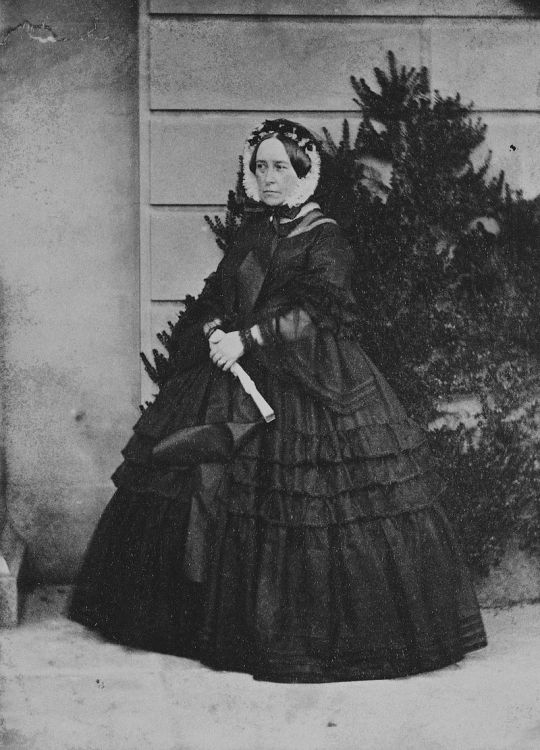
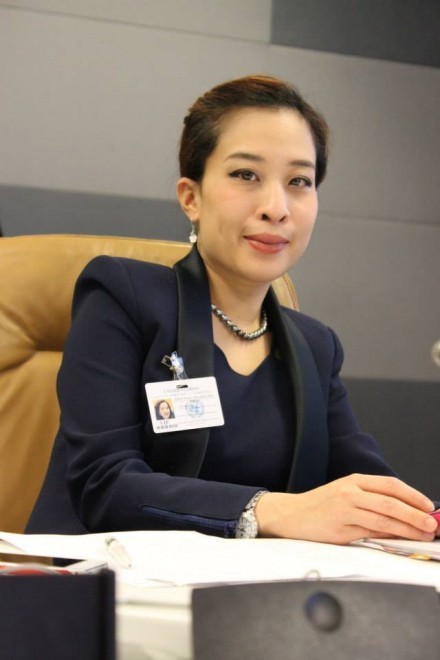
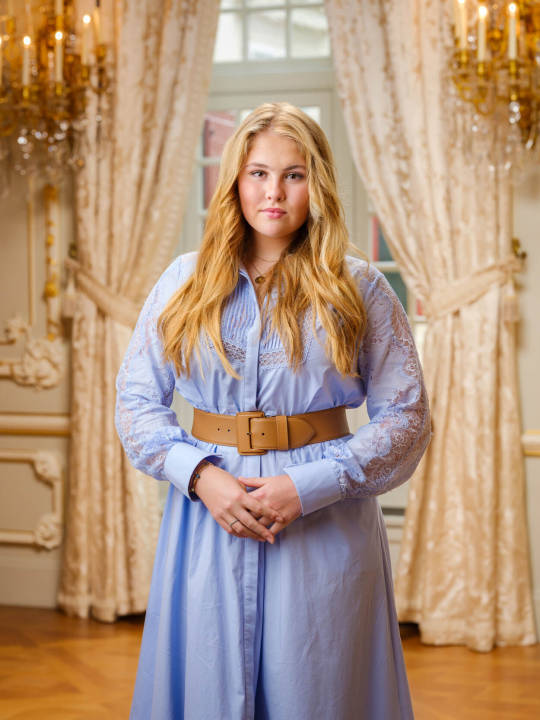
Royal birthdays for today December 7th:
Henry Stuart, King Consort of Scots, 1545
Louise Henriette of Nassau, Electress of Brandenburg, 1627
Maria Christina of Saxony, Princess of Carignano, 1770
Feodora of Leiningen, Princess of Hohenlohe-Langenburg, 1807
Bajrakitiyabha, Princess of Thailand, 1978
Catharina-Amalia, Princess of Orange, 2003
#henry stuart#Princess Catharina Amalia#Louise Henriette of Nassau#Feodora of Leiningen#Maria Christina of Saxony#princess Bajrakitiyabha#royal birthdays#long live the queue
41 notes
·
View notes
Text

feodora victoria, princess of hohenlohe-langenburg and duchess of saxe-meiningen
franz xaver winterhalter, 1855
#art#europe#fashion#aesthetic#history#art history#painting#christianity#monarchy#women in art#1800s art#19th century#portrait#germany#austria#franz xaver winterhalter#beautiful#inspiration#traditionalism
91 notes
·
View notes
Note
Sorry to bother you with a none ASOIAF ask but after reading some of your recent British royal family posts, I started to wonder was Queen Victoria particularly close to her half siblings? did they spend much time in England after their mother married the Duke of Kent?
It’s no bother! I promise. (For anyone who doesn’t know, Queen Victoria had two elder half-siblings, Feodora and Carl, from her mother Victoire’s first marriage, to Emich Carl, Prince of Leiningen; you can read more about how Victoire came to marry Victoria’s father, the Duke of Kent, in this post of mine.)
Despite a somewhat large age gap - Princess Feodora was 12 years older than Victoria - the two sisters were extremely close, and spent a considerable amount of time together in Victoria’s early years. Nearly every afternoon, the two princesses went out walking and riding with their governess, Louise Lehzen. Princess Feodora made no secret about how much she hated the stifled, unsocial life at Kensington Palace, where she had no friends her own age and was forced to converse in English, but she was clear that Victoria was one of the few bright spots: “When I look back upon those years which ought to have been the happiest in my life, I cannot help pitying myself. Not to have enjoyed the pleasures of youth is nothing, but to have been deprived of all intercourse and not one cheerful thought in that dismal existence of ours, was very hard. My only happy time was going or driving out with you and Lehzen; then I could speak or look as I liked.” Feodora was also keen to draw similarities between herself and Victoria, writing later that “[w]e both have not enjoyed a father’s love” and stating that their children would live much happier childhoods than Victoria and Feodora had. Unfortunately for the two sisters, Feodora was married off when she was just past 20 to Ernest, Prince of Hohenlohe-Langenburg; the Duchess of Kent and her chief adviser, Sir John Conroy, were eager to marry her to an almost penniless minor German royal to get her away from Victoria, where she might have been an ally against the Duchess. Though Prince Ernest was kind and handsome (despite being himself 13 years older than his bride), his relative poverty meant that Feodora would not be able to visit regularly.
Nevertheless, the two princesses kept up a regular correspondence that would end only with Feodora’s death, calling each other “dear sister”. Two months after the marriage, Feodora wrote “I was delighted to see a little letter from you directed to me from your darling hands. How often I should like to kiss them and your whole little person.” In May of that same year, Feodora sent birthday greetings to Victoria, stating “If I had wings and could fly like a bird, I should fly in at your window like the little robin today, and wish you many happy returns of the 24th and tell you how I love you, dearest sister, and how often I think of you and long to see you.” In 1830, Feodora made Victoria godmother to her first daughter, Elise, and when Feodor and her two eldest children, Carl and Elise, visited in 1834, Victoria exclaimed that her goddaughter was “a perfect little beauty”. Victoria was no less expressive in her diary about Feodora: she noted on June 6 that the day marked the arrival of “my DEAREST sister Feodora”, and when the Hohenlohe-Langenburgs left in July, Victoria wrote “I clasped her in my arms, and kissed her and cried as if my heart would break, so did she dearest Sister. We then tore ourselves from each other in the deepest grief … When I came home I was in such a state of grief that I knew not what to do with myself. I sobbed and cried most violently the whole morning.” When Victoria became queen in 1837, Feodora was one of the first two people to whom she wrote announcing her accession, right after “dearest, most beloved Uncle Leopold”. Perhaps the most touching sign of the close relationship between the sisters was a line written by Feodora in a paper marked to be given to Victoria after her, Feodora’s, death: “I can never thank you enough for all you have done for me, for your great love and tender affection. These feelings cannot die; they must and will live on in my soul — till we meet again, never more to be separated — and now you will not forget, your only own loving sister, Feodora”.
As for Carl, though … well, that relationship was substantially less close. Carl was a big proponent of the “Kensington System”, by which the Duchess of Conroy hoped to make Victoria totally dependent on herself and John Conroy. He was also a backer of John Conroy himself, writing that Conroy had “worked hard” to make Victoria a popular heir to the throne. The motive was personal: having married a penniless Bohemian aristocrat, Countess Maria Klebelsberg (who had once been a lady-in-waiting to Duchess Louise of Saxe-Coburg, the mother of Prince Albert), Prince Carl was looking to his mother and Conroy to fund his lifestyle and lavish rebuilding projects. Victoria could not forgive her brother for siding with her enemy, and wrote in her diary of “the wickedness of the Prince of Leiningen and his friend S.J.”. Prince Carl also tried to help Conroy convince Victoria after her 18th birthday that she would need a regency until she was 21, even writing to his sister that “[t]hey [her future subjects] expect that you will follow the path which your mother has gone for many years”. His elder son, however, was much closer to his aunt, entering the Royal Navy and eventually becoming an admiral.
#history#english history#british history#queen victoria#feodora of leiningen#carl prince of leiningen
33 notes
·
View notes